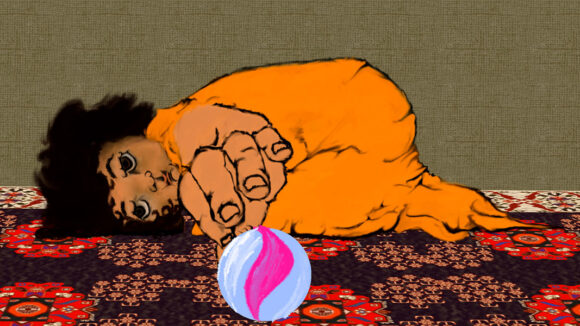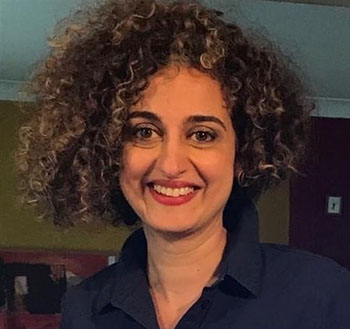

2025 Oscars Short Film Contenders: ‘And Granny Would Dance’ Director Maryam Mohajer
Cartoon Brew is putting the spotlight on animated short films that have qualified for the 2025 Oscars.
In this installment, we’re looking at And Granny Would Dance from Iranian-British filmmaker Maryam Mohajer. The short earned its Oscars qualification by winning best short animation at Rhodes Island International Film Festival and best short at Manchester Animation Festival.
Six-year-old Marmar observes how the adult women in her life navigate their relationships with their loved ones and each other. She listens in on her grandmother’s friends laughing about their partners as they play an illicit game of cards, while trying to figure out why her own grandma doesn’t dance anymore. Based on the director’s memories of her childhood in Iran, And Granny Would Dance is a beautifully woven tale of love, grief and resilience across generations, infused with music, dance, and empowering characters. The film is produced by British arts organization Animate Projects with the support of National Lottery funding from the BFI.
Cartoon Brew: Your intimate story is a tribute to the resilience of Iranian women. How is dancing part of this homage to both your grandparents and Iranian women as a whole?

Maryam Mohajer: Dancing can be a form of resilience – it is banned for women in Iran to dance in public. The way an Iranian woman starts to dance is very special as well. It’s a performance, it’s dramatic, there’s a big starting moment, there is a sense of power in it. When I look at an Iranian woman dancing, she looks as if she is on stage. Dancing is also a big part of Iranian life. I’ve seen Iranian people, friends, family, or complete strangers using dance as a distraction, a soothing mechanism, something to help them carry on; one minute they are upset, worried and maybe even scared, then, someone puts the music on, they start to dance and everything seems to be ok, even if just for a short time.
What was it about this story or concept that connected with you and compelled you to direct the film?
I have a video clip of my mum and her friends from three years ago. They are on an off-road outside Tehran. They have pulled their cars aside, turned the music up and are simply dancing and singing with this upbeat pop song with sad lyrics that talk about how spring is coming, but for the singer, without their beloved flower, there should be no spring. The whole performance from these women is for my mum’s benefit, who is also dancing and singing. At the time my mum and I hadn’t been able to see each other for three years.
I’m really fascinated by the concept of women as a community — specifically Iranian women. Once you put them in a place where they feel safe and relaxed, it becomes magical! It creates a cheekiness, power, and a sense of care and support that is quite unique. The story is also based on personal memories from my childhood. My background and culture where singing, dancing and even making jokes have become means for survival through hard times.
What did you learn through the experience of making this film, either production-wise, filmmaking-wise, creatively, or about the subject matter?
This was the first film that I got funding for, and I was fortunate to be awarded a grant from the BFI. It was also my first experience working with a producer. As a professional filmmaker, I learned a lot about working with and directing a bigger team. It was about how I could communicate my ideas and feelings to different people. Technically, And Granny Would Dance is my biggest project so far. It is my longest film and probably the most challenging; most of the film takes place in the same room, around the same table, with the same eight characters. It could easily become repetitive or boring. So I would consider and reconsider every single shot. It was also very helpful to have an editor – another first – on board to discuss the shots with. I always try to challenge myself creatively with every project. I experimented with a much bigger color palette this time, playing around with new different techniques. I mixed two completely different styles throughout the film; one for the real world and another for the imaginary world that is in the little girl’s mind who is our narrator.
As for the subject matter, the day we recorded the voice artists – all women – just confirmed what I mentioned about the magic that exists within a group of women. These women did not know each other before that day. We were in fact a bit worried. The characters were supposed to be close friends and we weren’t sure if this group of strangers could create that feeling. Nevertheless, the unity, cheekiness, and the energy that was born through those few hours was phenomenal! This played a great part in the general feeling and the energy of the film itself as well.
Can you describe how you developed your visual approach to the film? Why did you settle on this style/technique?
Part of it goes back to my painting background. I’m obsessed with textures and layers. I’m interested in what objects, elements, and images carry with them. So I would start from a hand-drawn character from one of my sketchbooks. I’d collage images from old Persian manuscripts, or a pattern that would remind me of the wallpaper at my grandparents’ house, etc. I would use Persian words to create patterns. For example, the tablecloth that’s on the table the characters are playing cards on is made of the Persian word for ‘tablecloth’ and the golden pattern on the tiny teacups is made of the word ‘teacup’ in Persian.
The nature of these characters also played a part. A character that keeps joking, talking, moving, and is also a bit tense, needs to be presented in a way that communicates all that energy and tension. This concept made its way into the animation as well as the design. There are some parts that I would plan, use references and carefully animate, but there were also some scenes like the dance part, that I would animate directly as I went, frame by frame. It felt like I was dancing myself. Talking about characters, because the narrator is a little girl, I looked into making the camera angles as if we were watching through her eyes. It was also about how close you would get to objects, such as teacups, tables, even people, as a child.
